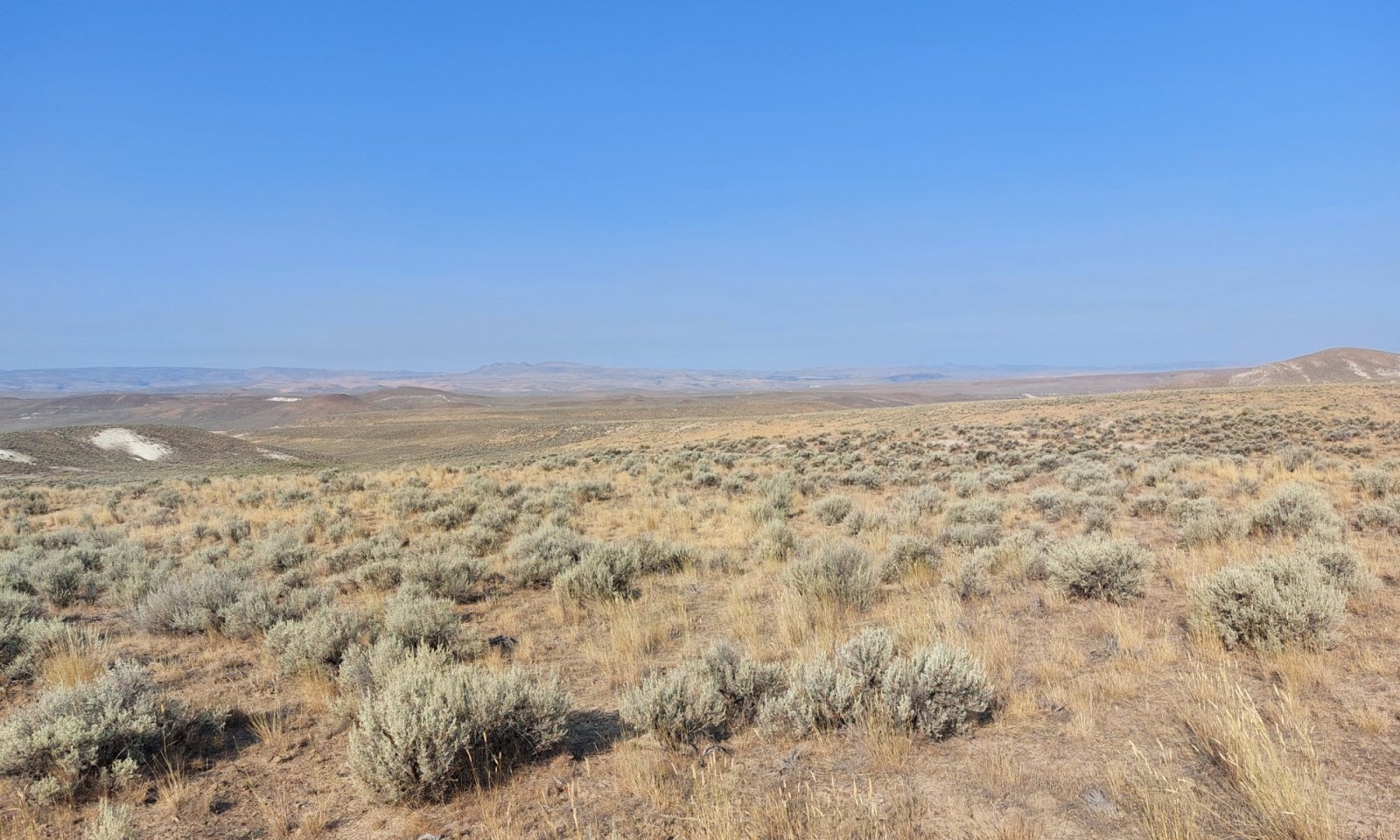

Natural Resources
Conservation Service
Ecological site BX010X00C022
Silty 9-12 PZ Snake River Warm Plains
Last updated: 5/16/2025
Accessed: 12/20/2025
General information
Provisional. A provisional ecological site description has undergone quality control and quality assurance review. It contains a working state and transition model and enough information to identify the ecological site.
MLRA notes
Major Land Resource Area (MLRA): 010X–Central Rocky and Blue Mountain Foothills
This MLRA is characterized by gently rolling to steep hills, plateaus, and low mountains at the foothills of the Blue Mountains in Oregon and the Central Rocky Mountains in Idaho. The geology of this area is highly varied and ranges from Holocene volcanics to Cretaceous sedimentary rocks. Mollisols are the dominant soil order and the soil climate is typified by mesic or frigid soil temperature regimes and xeric or aridic soil moisture regimes. Elevation ranges from 1,300 to 6,600 feet (395 to 2,010 meters), increasing from west to east. The climate is characterized by dry summers and snow-dominated winters with precipitation averaging eight to sixteen inches (205 to 405 millimeters) and increasing from west to east. These factors support plant communities with shrub-grass associations with considerable acreage of sagebrush grassland. Big sagebrush (Artemisia tridentata), bluebunch wheatgrass (Pseudoroegneria spicata), and Idaho fescue (Festuca idahoensis) are the dominant species. Scabland sagebrush (Artemisia rigida), little sagebrush (Artemisia arbuscula), and Sandberg bluegrass (Poa secunda) are often dominant on sites with shallow restrictive layers. Western juniper (Juniperus occidentalis) is one of the few common tree species and since European settlement has greatly expanded its extent in Oregon. Nearly half of the MLRA is federally owned and managed by the Bureau of Land Management. Most of the area is used for livestock grazing with areas accessible by irrigation often used for irrigated agriculture (USDA 2006).
LRU notes
The Snake River Warm Plains LRU is located between Oregon's Blue and Wallowa Mountains and the northwestern Snake River Plain. Characterized by rangeland soils on hills and mountains associated with basalt and exposed tuffaceous sediments. Plants are subject to wide temperature ranges, high evapotranspiration, and high early-season moisture stress. Temperature regime is mesic and the moisture regime is aridic. Mean annual precipitation is nine to twelve inches.
Ecological site concept
This site typically occurs on mid-elevation terraces in areas with gentle slopes less than twelve percent. Soils are moderately deep to deep consisting of predominately silt loams. In the reference condition, this site supports vegetation communities dominated by Wyoming big sagebrush (Artemisia tridentata ssp. wyomingensis) and bluebunch wheatgrass (Pseudoroegneria spicata) in lower precipitation areas and transitions to basin big sagebrush (Artemisia tridentata ssp. tridentata) in higher precipitation areas. The site receives nine to twelve inches of annual precipitation and soil temperature regime is mesic. Resistance and resilience to disturbance are low.
Associated sites
| R010XC020OR |
SR Loamy 9-12 PZ SR Loamy 9-12 PZ (Adjacent landscape positions with less fine sands in soil surface) |
|---|---|
| R010XC025OR |
SR Sandy 9-12 PZ SR Sandy 9-12 PZ (Adjacent landscape positions with higher sands in soil surface) |
| R010XC043OR |
SR South 9-12 PZ SR South 9-12 (Adjacent landforms with steeper, south-facing slopes) |
| R010XC064OR |
SR North 9-12 PZ SR North 9-12 PZ (Adjacent landforms with steeper, north-facing slopes) |
Similar sites
| R010XC020OR |
SR Loamy 9-12 PZ SR Loamy 9-12 PZ (different composition - bearded bluebunch dominant, less fine sand in surface) |
|---|
Table 1. Dominant plant species
| Tree |
Not specified |
|---|---|
| Shrub |
(1) Artemisia tridentata ssp. wyomingensis |
| Herbaceous |
(1) Pseudoroegneria spicata |
Legacy ID
R010XC022OR
Physiographic features
This site occurs on mid-elevation terraces in the Malheur, Owyhee, and adjacent Snake River drainage. Slopes typically range from two to twelve percent but sites are most frequently under ten percent. Elevations typically range between 2,500 to 3,500 feet but some sites have been found up to 4,000 feet.
Table 2. Representative physiographic features
| Landforms |
(1)
Terrace
(2) Hill |
|---|---|
| Elevation | 2,200 – 3,500 ft |
| Slope | 2 – 12% |
| Aspect | Aspect is not a significant factor |
Climatic features
The annual precipitation ranges from nine to twelve inches, most of which occurs in the form of snow during December through March. Localized, occasionally severe, convectional storms occur during the summer. The soil temperature regime is mesic with a mean annual air temperature of 52 degrees F. Temperature extremes range from -10 to 100 degrees F. The frost-free period ranges from 100 to 140 days. The optimum period for plant growth is from April through June.
Table 3. Representative climatic features
| Frost-free period (characteristic range) | 106-112 days |
|---|---|
| Freeze-free period (characteristic range) | 130-134 days |
| Precipitation total (characteristic range) | 10 in |
| Frost-free period (actual range) | 105-114 days |
| Freeze-free period (actual range) | 128-136 days |
| Precipitation total (actual range) | 10 in |
| Frost-free period (average) | 109 days |
| Freeze-free period (average) | 132 days |
| Precipitation total (average) | 10 in |
Figure 1. Monthly precipitation range
Figure 2. Monthly minimum temperature range
Figure 3. Monthly maximum temperature range
Figure 4. Monthly average minimum and maximum temperature
Figure 5. Annual precipitation pattern
Figure 6. Annual average temperature pattern
Climate stations used
-
(1) WESTFALL [USC00359176], Harper, OR
-
(2) VALE [USC00358797], Vale, OR
Influencing water features
This site is not typically associated with riparian or wetland features.
Soil features
The soils of this site are typically moderately deep to deep and well drained. Typically, the surface layer is a silt loam to very fine sandy loam eight to sixteen inches thick. The subsoil is a silt loam to clay loam. Depth to lacustrine or tuffaceous sediments ranges between 20 to 60 inches. A moderately deep duripan may be present but is infrequently found. Permeability is moderate and saturated hydraulic conductivity (Ksat) is moderately high. The available water holding capacity (AWC) is approximately four to six inches for the first forty inches of the profile. The potential for erosion is moderate. Soils are formed by eolian deposits over alluvial material or reworked ash deposits. The soil temperature regime is mesic and the soil moisture regime is aridic. The soil series Tubmountain, Farmell, and Morfitt most commonly typify the soils of this site.
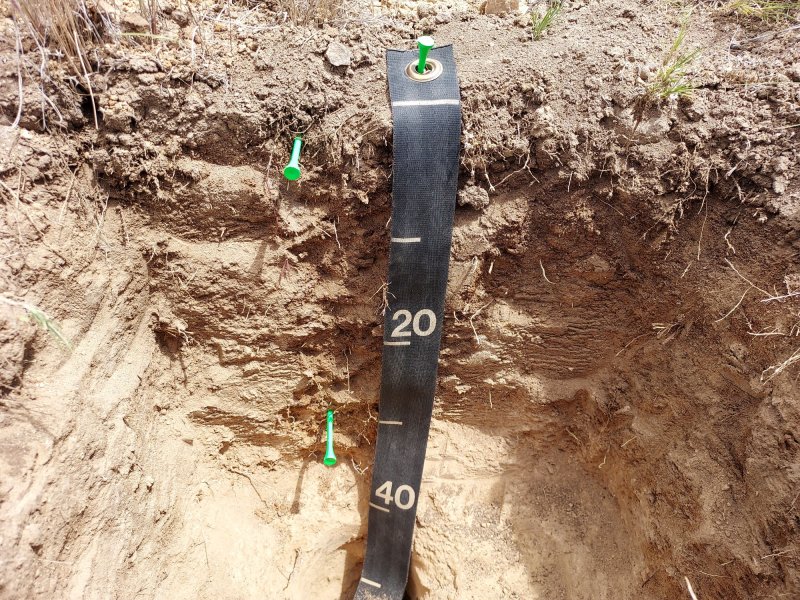
Figure 7.
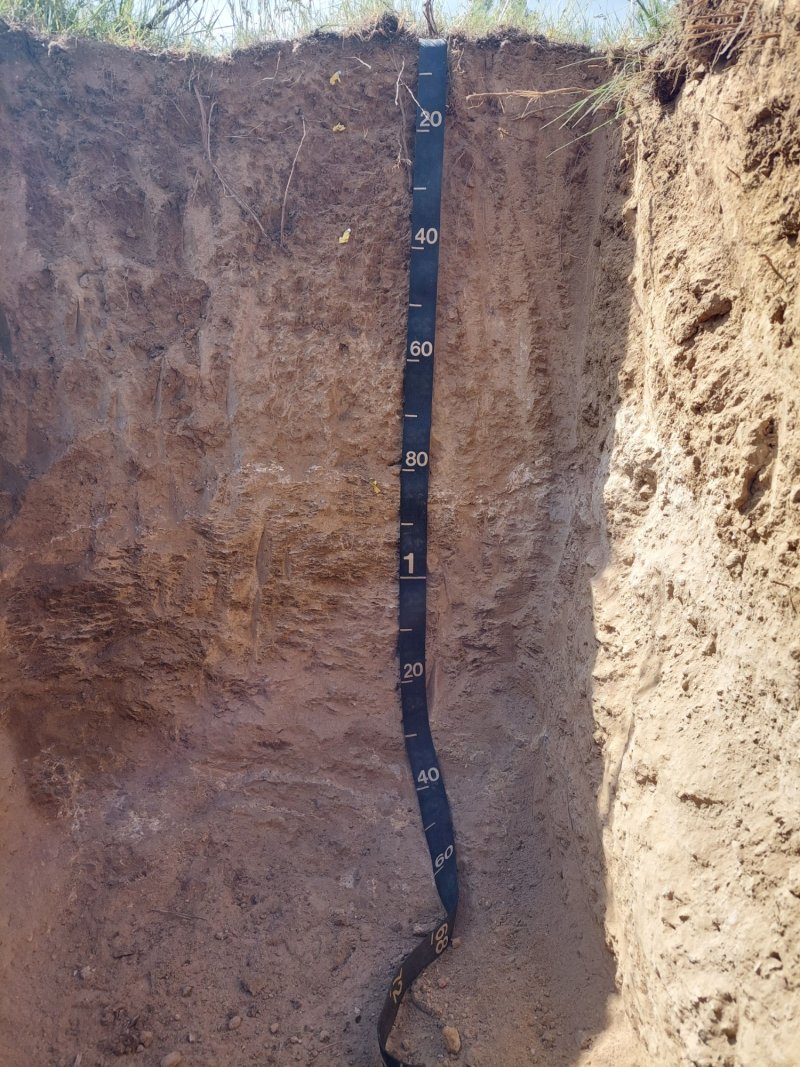
Figure 8.
Table 4. Representative soil features
| Parent material |
(1)
Loess
(2) Alluvium |
|---|---|
| Surface texture |
(1) Silt loam (2) Very fine sandy loam |
| Family particle size |
(1) Fine-loamy (2) Fine |
| Drainage class | Moderately well drained to well drained |
| Permeability class | Moderate |
| Soil depth | 20 – 60 in |
| Surface fragment cover <=3" | 2% |
| Surface fragment cover >3" | Not specified |
| Available water capacity (0-39.4in) |
5.43 – 6.43 in |
| Clay content (0-20in) |
17 – 23% |
| Soil reaction (1:1 water) (0-20in) |
6.9 – 7.2 |
Table 5. Representative soil features (actual values)
| Drainage class | Moderately well drained to well drained |
|---|---|
| Permeability class | Moderate |
| Soil depth | 20 – 60 in |
| Surface fragment cover <=3" | 5% |
| Surface fragment cover >3" | 2% |
| Available water capacity (0-39.4in) |
3.94 – 7.09 in |
| Clay content (0-20in) |
14 – 32% |
| Soil reaction (1:1 water) (0-20in) |
6.6 – 7.4 |
Ecological dynamics
Indicators and Range of Characteristics:
The potential native plant community is dominated by Wyoming big sagebrush (Artemisia tridentata ssp. wyomingensis) and bluebunch wheatgrass (Pseudoroegneria spicata). Thurber’s needlegrass (Achnatherum thurberianum) is prominent. Sandberg bluegrass (Poa secunda) is the dominant shallow-rooted perennial grass. A variety of forbs and shrubs are present. Vegetative composition of the reference community is approximately 80 percent grasses, 10 percent forbs, and 10 percent shrubs. The approximate ground cover is 70 to 80 percent (basal and crown).
Bluebunch wheatgrass increases on silty surfaces. Thurber’s needlegrass increases on very fine sandy loam surfaces and drier sites. Needle and thread (Hesperostipa comata) is present on coarser surfaces. Wyoming big sagebrush is dominant at most sites but basin big sagebrush (Artemisia tridentata ssp. tridentata) increases slightly at higher precipitations. Annual production increases at the upper end of the precipitation zone.
Response to Disturbance:
Ecological dynamics of this site are primarily driven by disturbance regimes including wildfire, grazing, and drought. Traditionally, wildfire was the primary driver of ecological change. These infrequent fires, often greater than a 100-year return, would result in the removal of woody species and create perennial grasslands (Pyke et al., 2014; Smith et al., 2023). Differing fuel loads and weather patterns, fires likely burned in mosaic patterns leaving intact sagebrush pockets and intact soil seed banks. Given enough time, sagebrush would expand back into its original territory (Hosna et al., 2023). Forbs at these sites were likely a minor component, and while important for pollinators, did not play a major role in determining ecological outcomes (Pyke et al., 2014).
With the introduction of invasive annual grasses, chiefly cheatgrass (Bromus tectorum) and medusahead (Taeniatherum caput-medusae), the traditional fire cycle changes. These annual grasses fill interspaces and create continuous fine fuels increasing size and often frequency of fire. The invasive annual grasses can recover quickly but Wyoming big sagebrush is killed and may not be able to recolonize before the next fire begins (Smith et al., 2023; Beck et al., 2012). This cycle creates a positive feedback loop in which shrubs and perennial grasses are removed from the system and invasive annual grasses dominate and noxious forbs continue to invade.
In opposition, some areas have seen an increase in fire return. In these cases, Wyoming big sagebrush and Sandberg bluegrass increase while bluebunch wheatgrass and Thurber’s needlegrass rapidly decrease (Davies et al., 2011). A similar pattern appears due to continued overutilization (Pyke et al., 2014). In addition, biological soil crusts are often removed leading to higher bare soil opening opportunities for annual grass invasion or increased soil erosion. The excessive erosion is most pronounced in drainage areas where deep incised gullies form.
Within the natural range of variability, this site is considered to have low resistance and resilience to disturbance. This is driven by warm annual temperatures and an aridic soil moisture regime (Chambers et al., 2014) making the site very susceptible to annual grass invasion (Miller et al., 2013).
State and transition model
More interactive model formats are also available.
View Interactive Models
Click on state and transition labels to scroll to the respective text
Ecosystem states
| T1A | - | Introduction of non-native species; inappropriate grazing management |
|---|---|---|
| T2A | - | Inappropriate grazing management |
| T2B | - | Fire, soil disruption, inapropriate grazing management |
| R3A | - | Shrub removal, possible perennial grass reseeding |
| T3A | - | Catastrophic fire, soil disturbing treatments, inappropriate grazing management |
| R4B | - | Annual grass treatment, reseeding |
| R4A | - | Annual grass treatment, reseeding |
State 1 submodel, plant communities
| 1.1A | - | Fire |
|---|---|---|
| 1.2A | - | Time without disturbance |
State 2 submodel, plant communities
| 2.1A | - | Time and lack of fire |
|---|---|---|
| 2.1B | - | Fire |
| 2.2A | - | Fire |
| 2.3A | - | Time without disturbance |
State 3 submodel, plant communities
| 3.1A | - | Fire |
|---|---|---|
| 3.2A | - | Time without disturbance |
State 4 submodel, plant communities
| 4.1A | - | Fire, mechanical shrub removal |
|---|
State 1
Reference
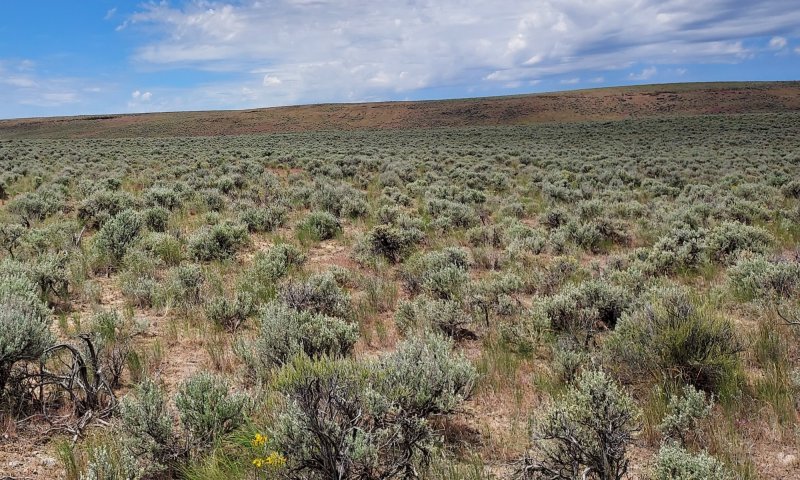
The Reference state is representative of the natural range of variability in pristine condition (Stringham et al., 2019). This state has no introduced plant species. Disturbance patterns reflect historic return cycles or an increased return has not reduced the sites resistance and resilience to disturbance. The Reference state has two communities; a grass shrub community and a perennial grass community. Community dynamics are controlled primarily by fire and time. All functional groups are present and a diverse forb component exists although it is not the dominant component. At the time of this writing, no sites were found in the Reference state so community information is inferred from current potential sites and historical data.
Characteristics and indicators. •No introduced plant species •All functional groups present •High plant vigor and reproductive capacity
Resilience management. Reference sites should be prioritized for protection whenever possible. Management should focus on conservation and protection above other uses. Surrounding landscapes should be managed to reduce non-native species introductions and other impacts (Maestas et al., 2022).
Dominant plant species
-
Wyoming big sagebrush (Artemisia tridentata ssp. wyomingensis), shrub
-
basin big sagebrush (Artemisia tridentata ssp. tridentata), shrub
-
bluebunch wheatgrass (Pseudoroegneria spicata), grass
-
Thurber's needlegrass (Achnatherum thurberianum), grass
-
Sandberg bluegrass (Poa secunda), grass
Community 1.1
Deep-rooted Bunchgrass and Wyoming Big Sagebrush
The reference plant community is dominated by Wyoming big sagebrush and bluebunch wheatgrass. Thurber’s needlegrass is prominent. Sandberg bluegrass is the dominant shallow rooted perennial grass. A variety of forbs and shrubs are present. Vegetative composition of the community is approximately 80 percent grasses, 10 percent forbs, and 10 percent shrubs. The approximate ground cover is 70 to 80 percent (basal and crown).
Dominant plant species
-
Wyoming big sagebrush (Artemisia tridentata ssp. wyomingensis), shrub
-
bluebunch wheatgrass (Pseudoroegneria spicata), grass
-
Thurber's needlegrass (Achnatherum thurberianum), grass
-
Sandberg bluegrass (Poa secunda), grass
Figure 9. Annual production by plant type (representative values) or group (midpoint values)
Table 6. Annual production by plant type
| Plant type | Low (lb/acre) |
Representative value (lb/acre) |
High (lb/acre) |
|---|---|---|---|
| Grass/Grasslike | 560 | 800 | 1120 |
| Forb | 70 | 100 | 140 |
| Shrub/Vine | 70 | 100 | 140 |
| Total | 700 | 1000 | 1400 |
Figure 10. Plant community growth curve (percent production by month). OR3711, B10 Low Elevation Mesic 9-12 Good Condition. B10 Low Elevation Mesic 9-12 Good Condition RPC.
| Jan | Feb | Mar | Apr | May | Jun | Jul | Aug | Sep | Oct | Nov | Dec |
|---|---|---|---|---|---|---|---|---|---|---|---|
| J | F | M | A | M | J | J | A | S | O | N | D |
| 0 | 0 | 5 | 15 | 35 | 25 | 10 | 0 | 10 | 0 | 0 | 0 |
Community 1.2
Perennial grasses
This plant community is dominated by bluebunch wheatgrass and Sandberg bluegrass. This community is the result of low-intensity fire so Wyoming big sagebrush will likely be present but only in an isolated island mosaic distribution. Sprouting shrubs may be present but infrequently. This community would be considered at risk of transitioning the Current Potential state since fire would have exposed more bare soil and increased the opportunity for introduction of non-native species.
Dominant plant species
-
Wyoming big sagebrush (Artemisia tridentata ssp. wyomingensis), shrub
-
bluebunch wheatgrass (Pseudoroegneria spicata), grass
-
Thurber's needlegrass (Achnatherum thurberianum), grass
-
Sandberg bluegrass (Poa secunda), grass
Figure 11. Annual production by plant type (representative values) or group (midpoint values)
Table 7. Annual production by plant type
| Plant type | Low (lb/acre) |
Representative value (lb/acre) |
High (lb/acre) |
|---|---|---|---|
| Grass/Grasslike | 500 | 750 | 1000 |
| Shrub/Vine | 100 | 200 | 300 |
| Forb | 50 | 75 | 100 |
| Total | 650 | 1025 | 1400 |
Figure 12. Plant community growth curve (percent production by month). OR3711, B10 Low Elevation Mesic 9-12 Good Condition. B10 Low Elevation Mesic 9-12 Good Condition RPC.
| Jan | Feb | Mar | Apr | May | Jun | Jul | Aug | Sep | Oct | Nov | Dec |
|---|---|---|---|---|---|---|---|---|---|---|---|
| J | F | M | A | M | J | J | A | S | O | N | D |
| 0 | 0 | 5 | 15 | 35 | 25 | 10 | 0 | 10 | 0 | 0 | 0 |
Pathway 1.1A
Community 1.1 to 1.2
Low-severity fire burns in a mosaic pattern leaving islands of sagebrush with perennial grass-dominated areas in between.
Context dependence. As fire severity increases, distance between sagebrush islands increases meaning more time for sagebrush to recover in burned areas.
Pathway 1.2A
Community 1.2 to 1.1
Time without fire allows sagebrush recruitment to increase and become more common across the landscape.
Context dependence. Sagebrush expansion can occur over very long time scales so recovery may take many years.
State 2
Current Potential
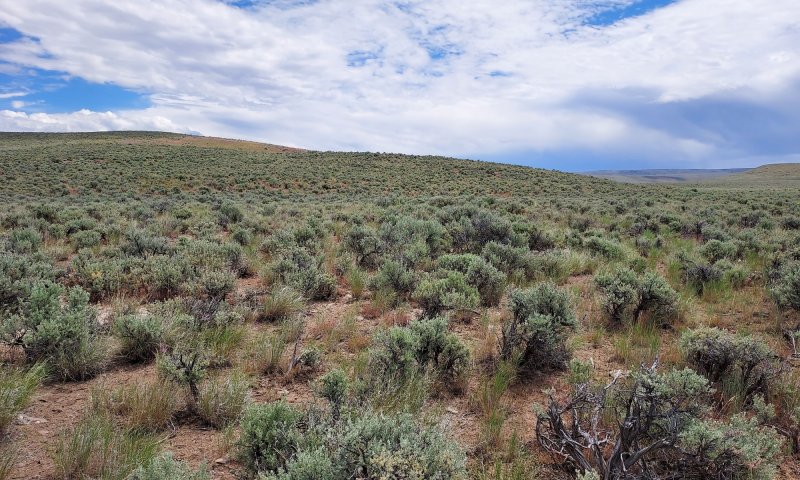
This state is similar to the Reference state but some amount of non-native species occur and species composition has been somewhat altered. Ecological functions often remain intact but due to the presence of these non-native species, resistance and resilience to disturbance have been reduced (Stringham et al., 2016). This state has three communities; a grass-shrub community, a shrub-grass community, and a grass community. The latter two represent two different "at-risk" communities, at risk of converting to the Shrubland state and at risk of converting to the Annual state, respectively.
Characteristics and indicators. •Low cover of introduced plant species (commonly less than fifteen percent total) •Deep-rooted perennial grass cover at or above twenty percent •All functional groups present with no significant decrease in reproductive capability
Resilience management. Sites in the Current Potential state should be prioritized for protection wherever possible, especially when in good quality condition. Management activities should focus on limiting seed sources of invasive annual grasses and promote perennial plant vigor and reproduction.
Dominant plant species
-
Wyoming big sagebrush (Artemisia tridentata ssp. wyomingensis), shrub
-
bluebunch wheatgrass (Pseudoroegneria spicata), grass
-
Sandberg bluegrass (Poa secunda), grass
Community 2.1
Deep-rooted Perennial Grasses and Shrubs

Deep-rooted perennial grasses, particularly bluebunch wheatgrass and crested wheatgrass are dominant and Wyoming big sagebrush is subdominant. Invasive annual grasses may be present but are not dominant. Forbs are generally a diverse mix of annual and perennial.
Dominant plant species
-
Wyoming big sagebrush (Artemisia tridentata ssp. wyomingensis), shrub
-
basin big sagebrush (Artemisia tridentata ssp. tridentata), shrub
-
bluebunch wheatgrass (Pseudoroegneria spicata), grass
-
crested wheatgrass (Agropyron cristatum), grass
Figure 13. Annual production by plant type (representative values) or group (midpoint values)
Table 8. Annual production by plant type
| Plant type | Low (lb/acre) |
Representative value (lb/acre) |
High (lb/acre) |
|---|---|---|---|
| Grass/Grasslike | 400 | 550 | 700 |
| Shrub/Vine | 200 | 360 | 500 |
| Forb | 25 | 40 | 50 |
| Total | 625 | 950 | 1250 |
Table 9. Ground cover
| Tree foliar cover | 0% |
|---|---|
| Shrub/vine/liana foliar cover | 10-20% |
| Grass/grasslike foliar cover | 40-60% |
| Forb foliar cover | 0-5% |
| Non-vascular plants | 0-1% |
| Biological crusts | 0% |
| Litter | 30-40% |
| Surface fragments >0.25" and <=3" | 0-5% |
| Surface fragments >3" | 0-5% |
| Bedrock | 0% |
| Water | 0% |
| Bare ground | 20-30% |
Table 10. Soil surface cover
| Tree basal cover | 0% |
|---|---|
| Shrub/vine/liana basal cover | 0-5% |
| Grass/grasslike basal cover | 5-10% |
| Forb basal cover | 0% |
| Non-vascular plants | 0-5% |
| Biological crusts | 0% |
| Litter | 0-2% |
| Surface fragments >0.25" and <=3" | 0-5% |
| Surface fragments >3" | 0-5% |
| Bedrock | 0% |
| Water | 0% |
| Bare ground | 70-85% |
Figure 14. Plant community growth curve (percent production by month). OR3711, B10 Low Elevation Mesic 9-12 Good Condition. B10 Low Elevation Mesic 9-12 Good Condition RPC.
| Jan | Feb | Mar | Apr | May | Jun | Jul | Aug | Sep | Oct | Nov | Dec |
|---|---|---|---|---|---|---|---|---|---|---|---|
| J | F | M | A | M | J | J | A | S | O | N | D |
| 0 | 0 | 5 | 15 | 35 | 25 | 10 | 0 | 10 | 0 | 0 | 0 |
Community 2.2
Shrubs and Perennial Grasses
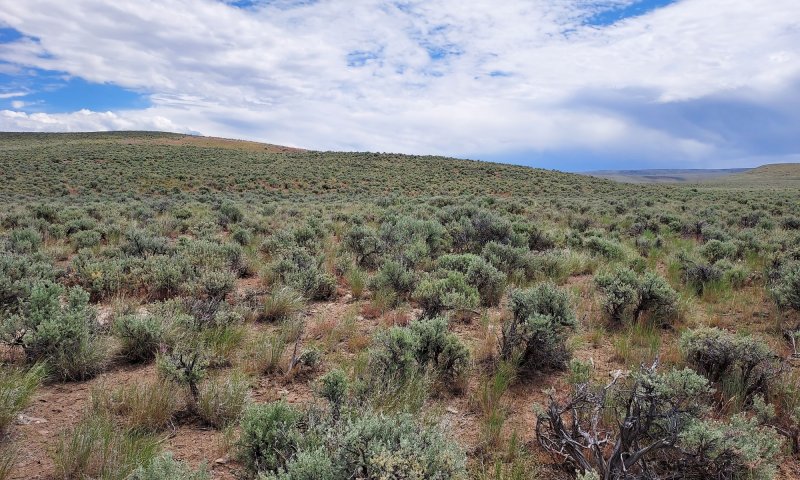
Wyoming big sagebrush is the dominant species and perennial grasses are sub-dominant. Sandberg bluegrass increases over deep-rooted perennial species as sagebrush increases to the point of using available deeper resources. Forbs are diverse and widespread. Annual invasive grasses are present but not dominant. This community is at risk of crossing a threshold and transitioning to the Shrubland state.
Dominant plant species
-
Wyoming big sagebrush (Artemisia tridentata ssp. wyomingensis), shrub
-
bluebunch wheatgrass (Pseudoroegneria spicata), grass
-
Sandberg bluegrass (Poa secunda), grass
Figure 15. Annual production by plant type (representative values) or group (midpoint values)
Table 11. Annual production by plant type
| Plant type | Low (lb/acre) |
Representative value (lb/acre) |
High (lb/acre) |
|---|---|---|---|
| Shrub/Vine | 200 | 350 | 500 |
| Grass/Grasslike | 190 | 320 | 450 |
| Forb | 10 | 30 | 50 |
| Total | 400 | 700 | 1000 |
Table 12. Ground cover
| Tree foliar cover | 0% |
|---|---|
| Shrub/vine/liana foliar cover | 5-15% |
| Grass/grasslike foliar cover | 45-65% |
| Forb foliar cover | 5-10% |
| Non-vascular plants | 0-3% |
| Biological crusts | 0% |
| Litter | 20-40% |
| Surface fragments >0.25" and <=3" | 0-3% |
| Surface fragments >3" | 0-3% |
| Bedrock | 0% |
| Water | 0% |
| Bare ground | 10-30% |
Table 13. Soil surface cover
| Tree basal cover | 0% |
|---|---|
| Shrub/vine/liana basal cover | 0-2% |
| Grass/grasslike basal cover | 5-15% |
| Forb basal cover | 0-2% |
| Non-vascular plants | 0-2% |
| Biological crusts | 0% |
| Litter | 0-2% |
| Surface fragments >0.25" and <=3" | 0-5% |
| Surface fragments >3" | 0-5% |
| Bedrock | 0% |
| Water | 0% |
| Bare ground | 80-90% |
Figure 16. Plant community growth curve (percent production by month). OR3711, B10 Low Elevation Mesic 9-12 Good Condition. B10 Low Elevation Mesic 9-12 Good Condition RPC.
| Jan | Feb | Mar | Apr | May | Jun | Jul | Aug | Sep | Oct | Nov | Dec |
|---|---|---|---|---|---|---|---|---|---|---|---|
| J | F | M | A | M | J | J | A | S | O | N | D |
| 0 | 0 | 5 | 15 | 35 | 25 | 10 | 0 | 10 | 0 | 0 | 0 |
Community 2.3
Perennial Grasses and Annual Grass
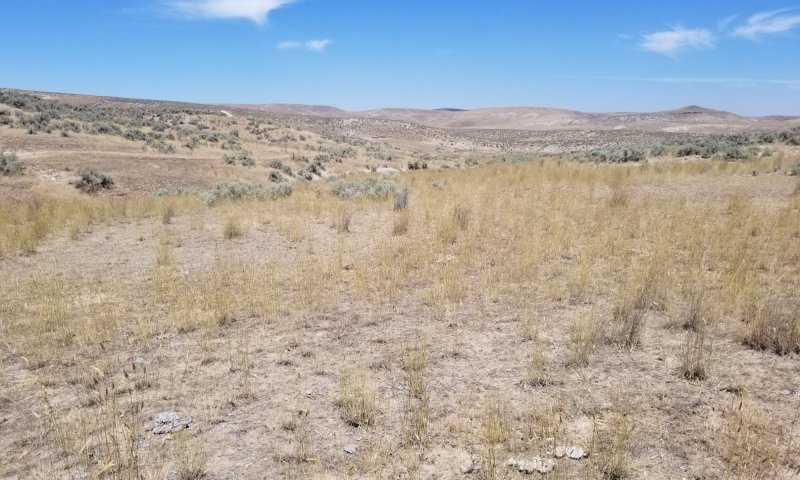
Shallow-rooted bunchgrasses, particularly Sandberg bluegrass, are dominant. Bluebunch wheatgrass is still present but may be reduced compared to other current potential sites. Depending on fire severity, Wyoming big sagebrush may not be present in high-severity fires or only found in isolated pockets in low-severity patchy fires. Forb species diversity is likely reduced. Invasive annual grasses are likely increasing. This community is at risk of crossing a threshold and transitioning to the Annual state.
Dominant plant species
-
bluebunch wheatgrass (Pseudoroegneria spicata), grass
-
Sandberg bluegrass (Poa secunda), grass
Figure 17. Annual production by plant type (representative values) or group (midpoint values)
Table 14. Annual production by plant type
| Plant type | Low (lb/acre) |
Representative value (lb/acre) |
High (lb/acre) |
|---|---|---|---|
| Grass/Grasslike | 400 | 550 | 700 |
| Shrub/Vine | 60 | 75 | 90 |
| Forb | 40 | 50 | 60 |
| Total | 500 | 675 | 850 |
Table 15. Ground cover
| Tree foliar cover | 0% |
|---|---|
| Shrub/vine/liana foliar cover | 0% |
| Grass/grasslike foliar cover | 65-75% |
| Forb foliar cover | 2-5% |
| Non-vascular plants | 0-2% |
| Biological crusts | 0% |
| Litter | 15-25% |
| Surface fragments >0.25" and <=3" | 0-2% |
| Surface fragments >3" | 0-2% |
| Bedrock | 0% |
| Water | 0% |
| Bare ground | 2-10% |
Table 16. Soil surface cover
| Tree basal cover | 0% |
|---|---|
| Shrub/vine/liana basal cover | 0% |
| Grass/grasslike basal cover | 10-20% |
| Forb basal cover | 0-2% |
| Non-vascular plants | 0-2% |
| Biological crusts | 0% |
| Litter | 0-2% |
| Surface fragments >0.25" and <=3" | 0-2% |
| Surface fragments >3" | 0-2% |
| Bedrock | 0% |
| Water | 0% |
| Bare ground | 70-80% |
Figure 18. Plant community growth curve (percent production by month). OR3712, B10 Low Elevation Mesic 9-12 Fair Condition. B10 Low Elevation Mesic 9-12 Fair Condition RPC.
| Jan | Feb | Mar | Apr | May | Jun | Jul | Aug | Sep | Oct | Nov | Dec |
|---|---|---|---|---|---|---|---|---|---|---|---|
| J | F | M | A | M | J | J | A | S | O | N | D |
| 0 | 0 | 10 | 25 | 35 | 20 | 5 | 0 | 5 | 0 | 0 | 0 |
Pathway 2.1A
Community 2.1 to 2.2


Time without fire allows shrubs to become dominant.
Context dependence. Grazing may speed this transition by reducing deep-rooted perennial grass cover.
Pathway 2.1B
Community 2.1 to 2.3


Fire reduces non-sprouting shrubs allowing grasses to become dominant.
Context dependence. Fire severity or likelihood of fire may increase following high precipitation years that increase vegetative production.
Pathway 2.2A
Community 2.2 to 2.3


Fire removes shrubs and opens space for deep-rooted perennial grasses to become dominant.
Context dependence. Fire severity or likelihood may increase following high precipitation years that increase vegetative production.
Pathway 2.3A
Community 2.3 to 2.1


Time without fire allows shrubs to reestablish.
Context dependence. Higher severity fire will increase distance between unburned pockets and increase time for non-sprouting shrubs to reestablish.
State 3
Shrubland
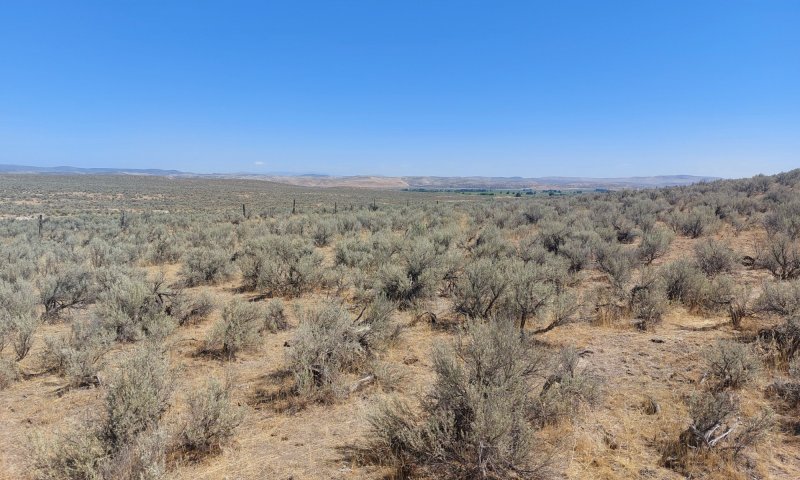
This state is dominated by shrubs and shallow-rooted perennial grasses and is a result of overgrazing especially during key growth periods of cool-season bunchgrasses. Deep-rooted perennial grass has been reduced or completely excluded rarely exceeding five percent foliar cover. This state consists of two communities, a Wyoming big sagebrush and shallow-rooted grass community, and a shallow-rooted grass community (Hanna and Fulgham, 2015). Although highly variable, invasive annual grass cover is often higher than in the current potential state. Without deep-rooted grasses, this state is more prone to erosion than the current potential state.
Characteristics and indicators. •Typically less than five percent cover of deep-rooted perennial grasses. •High cover of shallow-rooted perennial grass •Increased invasive annual grass but not enough to become a dominant component.
Resilience management. Management actions should focus on reintroduction of deep-rooted perennial grasses. Invasive annual grass control may also be a priority to avoid transitioning to an annual state.
Dominant plant species
-
Wyoming big sagebrush (Artemisia tridentata ssp. wyomingensis), shrub
-
bulbous bluegrass (Poa bulbosa), grass
-
Sandberg bluegrass (Poa secunda), grass
Community 3.1
Shrubs and Shallow-rooted Perennial Grasses
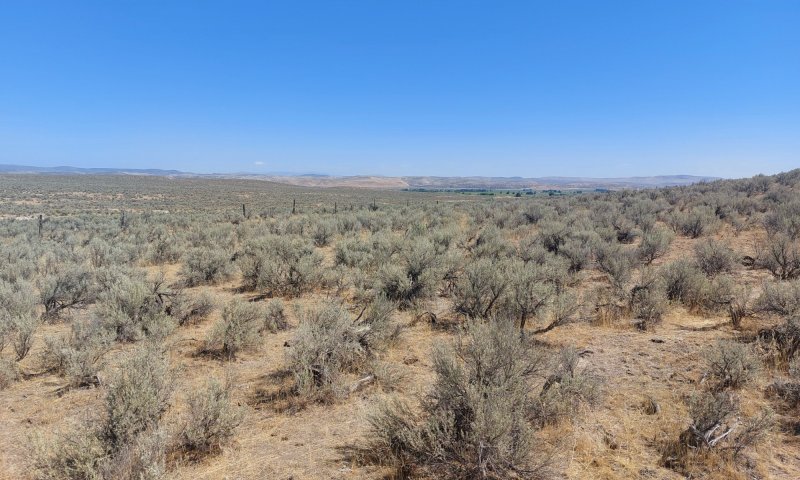
Wyoming big sagebrush and Sandberg bluegrass are dominant. Deep-rooted perennial grasses are greatly reduced or missing entirely. Invasive annual grasses may increase.
Dominant plant species
-
Wyoming big sagebrush (Artemisia tridentata ssp. wyomingensis), shrub
-
Sandberg bluegrass (Poa secunda), grass
Figure 19. Annual production by plant type (representative values) or group (midpoint values)
Table 17. Annual production by plant type
| Plant type | Low (lb/acre) |
Representative value (lb/acre) |
High (lb/acre) |
|---|---|---|---|
| Shrub/Vine | 300 | 350 | 450 |
| Grass/Grasslike | 145 | 220 | 350 |
| Forb | 5 | 30 | 50 |
| Total | 450 | 600 | 850 |
Table 18. Ground cover
| Tree foliar cover | 0% |
|---|---|
| Shrub/vine/liana foliar cover | 15-25% |
| Grass/grasslike foliar cover | 25-35% |
| Forb foliar cover | 0-5% |
| Non-vascular plants | 0% |
| Biological crusts | 0% |
| Litter | 30-45% |
| Surface fragments >0.25" and <=3" | 0-2% |
| Surface fragments >3" | 0-2% |
| Bedrock | 0% |
| Water | 0% |
| Bare ground | 15-25% |
Table 19. Soil surface cover
| Tree basal cover | 0% |
|---|---|
| Shrub/vine/liana basal cover | 0-2% |
| Grass/grasslike basal cover | 2-10% |
| Forb basal cover | 0-2% |
| Non-vascular plants | 0-2% |
| Biological crusts | 0% |
| Litter | 0-2% |
| Surface fragments >0.25" and <=3" | 2-10% |
| Surface fragments >3" | 2-10% |
| Bedrock | 0% |
| Water | 0% |
| Bare ground | 70-90% |
Figure 20. Plant community growth curve (percent production by month). OR3712, B10 Low Elevation Mesic 9-12 Fair Condition. B10 Low Elevation Mesic 9-12 Fair Condition RPC.
| Jan | Feb | Mar | Apr | May | Jun | Jul | Aug | Sep | Oct | Nov | Dec |
|---|---|---|---|---|---|---|---|---|---|---|---|
| J | F | M | A | M | J | J | A | S | O | N | D |
| 0 | 0 | 10 | 25 | 35 | 20 | 5 | 0 | 5 | 0 | 0 | 0 |
Community 3.2
Shallow-rooted Perennial Grass and Annual Grasses
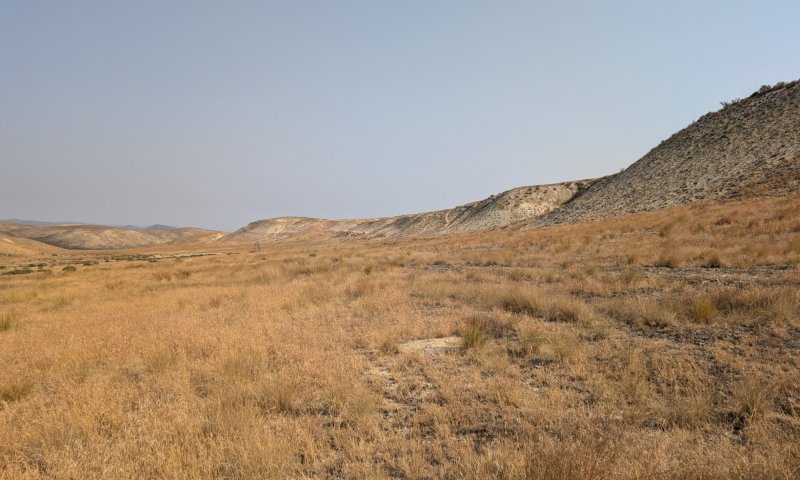
In this community, Wyoming big sagebrush has become very reduced or missing. Sandberg bluegrass and bulbous bluegrass are dominant. Non-native forbs and invasive annual grasses may increase. Deep-rooted perennial grasses are also a minor component or missing.
Dominant plant species
-
bulbous bluegrass (Poa bulbosa), grass
-
Sandberg bluegrass (Poa secunda), grass
Figure 21. Annual production by plant type (representative values) or group (midpoint values)
Table 20. Annual production by plant type
| Plant type | Low (lb/acre) |
Representative value (lb/acre) |
High (lb/acre) |
|---|---|---|---|
| Grass/Grasslike | 120 | 200 | 270 |
| Forb | 55 | 75 | 105 |
| Total | 175 | 275 | 375 |
Table 21. Ground cover
| Tree foliar cover | 0% |
|---|---|
| Shrub/vine/liana foliar cover | 0% |
| Grass/grasslike foliar cover | 30-60% |
| Forb foliar cover | 5-10% |
| Non-vascular plants | 0% |
| Biological crusts | 0% |
| Litter | 45-65% |
| Surface fragments >0.25" and <=3" | 0-1% |
| Surface fragments >3" | 0-1% |
| Bedrock | 0% |
| Water | 0% |
| Bare ground | 12-18% |
Table 22. Soil surface cover
| Tree basal cover | 0% |
|---|---|
| Shrub/vine/liana basal cover | 0% |
| Grass/grasslike basal cover | 5-15% |
| Forb basal cover | 0% |
| Non-vascular plants | 0% |
| Biological crusts | 0% |
| Litter | 0% |
| Surface fragments >0.25" and <=3" | 0-2% |
| Surface fragments >3" | 0-2% |
| Bedrock | 0% |
| Water | 0% |
| Bare ground | 80-90% |
Figure 22. Plant community growth curve (percent production by month). OR3713, B10 Low Elevation 9-12 Annual Dominated. B10 Low Elevation 9-12 Annual Dominated RPC.
| Jan | Feb | Mar | Apr | May | Jun | Jul | Aug | Sep | Oct | Nov | Dec |
|---|---|---|---|---|---|---|---|---|---|---|---|
| J | F | M | A | M | J | J | A | S | O | N | D |
| 0 | 0 | 20 | 30 | 40 | 5 | 0 | 0 | 5 | 0 | 0 | 0 |
Pathway 3.1A
Community 3.1 to 3.2


Increased fire frequency pushes out non-sprouting shrubs allowing shallow-rooted and annual grasses to become dominant.
Context dependence. Higher precipitation may lead to higher litter production and increased fire probability.
Pathway 3.2A
Community 3.2 to 3.1


Time without disturbance can allow for shrub recolonization.
Context dependence. Rate of shrub recolonization will depend on distance to a seed source.
State 4
Annual
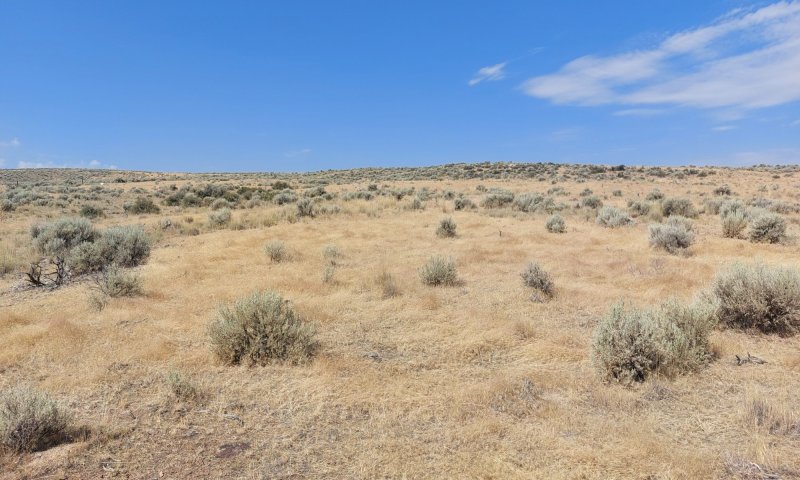
This state is dominated by invasive annual grasses. These grasses increase litter amounts which inhibits deep-rooted perennial grass recruitment and increases fire frequency. These two effects create a positive feedback loop that increases invasive annual grass populations (Reisner et al., 2013).
Characteristics and indicators. •Annual grass foliar cover greater than 25 percent •Sagebrush cover is variable but even when common, interspaces dominated by invasive annual grasses. •Herbaceous litter cover can be higher than other states
Resilience management. Any management actions should focus on reducing annual grass cover and limiting its spread to other areas (Smith et al., 2022).
Dominant plant species
-
cheatgrass (Bromus tectorum), grass
-
medusahead (Taeniatherum caput-medusae), grass
Community 4.1
Annual Grass and Shrubs
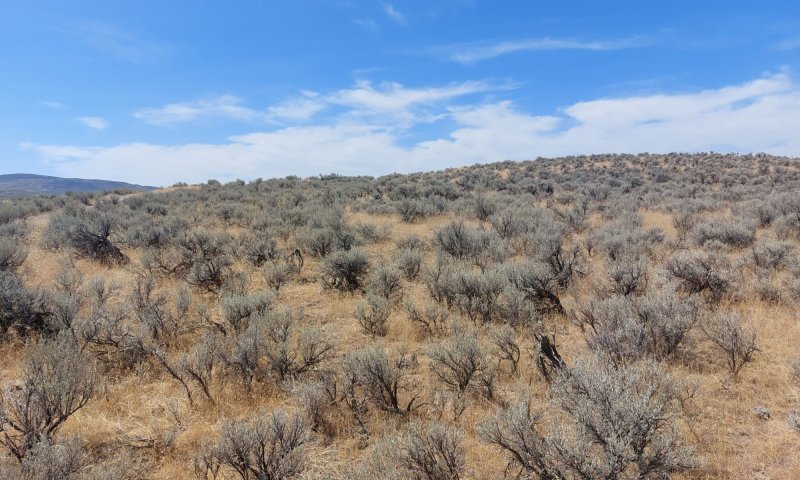
Introduced annual grasses are the dominant component of this community. Wyoming big sagebrush is still present but annual grasses and shallow-rooting perennial grasses fill all interspaces. If fire occurs, sagebrush may be replaced by sprouting rabbitbrush species.
Resilience management. Any action should focus on reducing invasive annual grass population to allow recovery of native species.
Dominant plant species
-
Wyoming big sagebrush (Artemisia tridentata ssp. wyomingensis), shrub
-
yellow rabbitbrush (Chrysothamnus viscidiflorus), shrub
-
cheatgrass (Bromus tectorum), grass
-
medusahead (Taeniatherum caput-medusae), grass
-
Sandberg bluegrass (Poa secunda), grass
Figure 23. Annual production by plant type (representative values) or group (midpoint values)
Table 23. Annual production by plant type
| Plant type | Low (lb/acre) |
Representative value (lb/acre) |
High (lb/acre) |
|---|---|---|---|
| Grass/Grasslike | 200 | 350 | 500 |
| Shrub/Vine | 150 | 200 | 250 |
| Forb | 50 | 75 | 100 |
| Total | 400 | 625 | 850 |
Table 24. Ground cover
| Tree foliar cover | 0% |
|---|---|
| Shrub/vine/liana foliar cover | 18-25% |
| Grass/grasslike foliar cover | 50-60% |
| Forb foliar cover | 0-2% |
| Non-vascular plants | 0% |
| Biological crusts | 0% |
| Litter | 55-65% |
| Surface fragments >0.25" and <=3" | 0-2% |
| Surface fragments >3" | 0-2% |
| Bedrock | 0% |
| Water | 0% |
| Bare ground | 3-7% |
Table 25. Soil surface cover
| Tree basal cover | 0% |
|---|---|
| Shrub/vine/liana basal cover | 0% |
| Grass/grasslike basal cover | 2-7% |
| Forb basal cover | 0-5% |
| Non-vascular plants | 0-3% |
| Biological crusts | 0% |
| Litter | 0% |
| Surface fragments >0.25" and <=3" | 0-5% |
| Surface fragments >3" | 0-5% |
| Bedrock | 0% |
| Water | 0% |
| Bare ground | 85-95% |
Figure 24. Plant community growth curve (percent production by month). OR3713, B10 Low Elevation 9-12 Annual Dominated. B10 Low Elevation 9-12 Annual Dominated RPC.
| Jan | Feb | Mar | Apr | May | Jun | Jul | Aug | Sep | Oct | Nov | Dec |
|---|---|---|---|---|---|---|---|---|---|---|---|
| J | F | M | A | M | J | J | A | S | O | N | D |
| 0 | 0 | 20 | 30 | 40 | 5 | 0 | 0 | 5 | 0 | 0 | 0 |
Community 4.2
Annual Grass
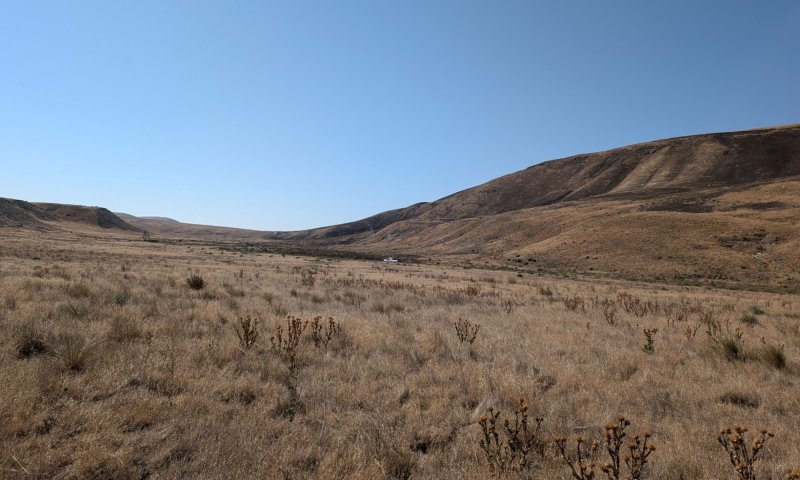
Introduced annual grasses are dominant. Dominant invasive grasses are cheatgrass and medusahead. Introduced forbs such as prickly lettuce (Lactuca serriola) , redstem stork's bill (Erodium cicutarium), and Scotch cottonthistle (Onopordum acanthium) may be common throughout. Basin big sagebrush and Wyoming big sagebrush may be present but only in trace amounts and will likely be removed completely with repeated burns.
Resilience management. Any management actions should focus on the removal of invasive annual grasses. Seedbanks in this community may be depleted of native species so management actions may need to incorporate seeding with desirable plant species.
Dominant plant species
-
cheatgrass (Bromus tectorum), grass
-
medusahead (Taeniatherum caput-medusae), grass
Figure 25. Annual production by plant type (representative values) or group (midpoint values)
Table 26. Annual production by plant type
| Plant type | Low (lb/acre) |
Representative value (lb/acre) |
High (lb/acre) |
|---|---|---|---|
| Grass/Grasslike | 350 | 500 | 750 |
| Forb | 50 | 70 | 120 |
| Shrub/Vine | 25 | 55 | 80 |
| Total | 425 | 625 | 950 |
Table 27. Ground cover
| Tree foliar cover | 0% |
|---|---|
| Shrub/vine/liana foliar cover | 3-5% |
| Grass/grasslike foliar cover | 80-90% |
| Forb foliar cover | 0-5% |
| Non-vascular plants | 0% |
| Biological crusts | 0% |
| Litter | 40-80% |
| Surface fragments >0.25" and <=3" | 0-1% |
| Surface fragments >3" | 0-1% |
| Bedrock | 0% |
| Water | 0% |
| Bare ground | 1-5% |
Table 28. Soil surface cover
| Tree basal cover | 0% |
|---|---|
| Shrub/vine/liana basal cover | 0% |
| Grass/grasslike basal cover | 10-25% |
| Forb basal cover | 0% |
| Non-vascular plants | 0-3% |
| Biological crusts | 0% |
| Litter | 0% |
| Surface fragments >0.25" and <=3" | 2-8% |
| Surface fragments >3" | 2-8% |
| Bedrock | 0% |
| Water | 0% |
| Bare ground | 70-90% |
Figure 26. Plant community growth curve (percent production by month). OR3713, B10 Low Elevation 9-12 Annual Dominated. B10 Low Elevation 9-12 Annual Dominated RPC.
| Jan | Feb | Mar | Apr | May | Jun | Jul | Aug | Sep | Oct | Nov | Dec |
|---|---|---|---|---|---|---|---|---|---|---|---|
| J | F | M | A | M | J | J | A | S | O | N | D |
| 0 | 0 | 20 | 30 | 40 | 5 | 0 | 0 | 5 | 0 | 0 | 0 |
Pathway 4.1A
Community 4.1 to 4.2


Fire occurs eliminating shrub component. Mechanical shrub removal could cause a similar shift.
Context dependence. High precipitation may lead to higher annual grass biomass and an increase in fine fuels. Fine fuel increase can cause more frequent fire return.
Transition T1A
State 1 to 2


Introduction of non-native species. Inappropriate grazing management could also aid in susceptibility of the site to invasion.
Context dependence. Circumstances that increase bare soil such as drought or soil disturbing activities, may increase opportunities for non-native species to invade.
Transition T2A
State 2 to 3


Inappropriate grazing management, repeated overgrazing reduces deep-rooted perennial grasses and shifts to shrubs and shallow-rooted grasses increasing bare soil and possible soil erosion.
Context dependence. Soil vulnerability to compaction will be highest in spring when soil is saturated and unfrozen.
Transition T2B
State 2 to 4


High-intensity or frequent fire that removes the sagebrush component from the site. Soil-disturbing treatments or repeated overutilization may also cause this transition.
Context dependence. The transition rate will depend on several factors including existing plant cover, biological soil crust integrity, seed bank integrity, and recent weather patterns.
Restoration pathway R3A
State 3 to 2


Mowing shrubs may allow for perennial grasses to become more dominant.
Context dependence. Actions to remove Wyoming big sagebrush increase the risk of invasive annual grasses becoming prevalent. Recovery may depend on existing plant understory and the ability to control annual grasses while recovery takes place.
Transition T3A
State 3 to 4


High-intensity or frequent fire. Sagebrush removal activities that disturb soil.
Context dependence. Transition rate will depend on existing cover and seedbank integrity.
Restoration pathway R4B
State 4 to 2


Treatment of annual grasses with herbicide coupled with seeding of desired native species.
Context dependence. Overall success may depend on above average yearly precipitation increasing establishment success.
Restoration pathway R4A
State 4 to 3


Targeted shrub planting and fire breaks may keep fire out of the site long enough for shrubs to recover.
Context dependence. Herbicide application can help control invasive annual grass populations to support shrub growth.
Additional community tables
Table 29. Community 1.1 plant community composition
| Group | Common name | Symbol | Scientific name | Annual production (lb/acre) | Foliar cover (%) | |
|---|---|---|---|---|---|---|
|
Grass/Grasslike
|
||||||
| 1 | Perennial moderately deep-rooted bunchgrasses | 460–800 | ||||
| bluebunch wheatgrass | PSSP6 | Pseudoroegneria spicata | 550–650 | – | ||
| Thurber's needlegrass | ACTH7 | Achnatherum thurberianum | 100–200 | – | ||
| 4 | Perennial shallow-rooted bunchgrasses | 30–70 | ||||
| Sandberg bluegrass | POSE | Poa secunda | 30–70 | – | ||
| 5 | Other perennial grasses | 70–250 | ||||
| needle and thread | HECO26 | Hesperostipa comata | 0–80 | – | ||
| basin wildrye | LECI4 | Leymus cinereus | 0–30 | – | ||
| squirreltail | ELEL5 | Elymus elymoides | 0–30 | – | ||
| Idaho fescue | FEID | Festuca idahoensis | 0–30 | – | ||
| foxtail wheatgrass | PSSA2 | ×Pseudelymus saxicola | 0–20 | – | ||
|
Forb
|
||||||
| 7 | Perennial forbs | 50–80 | ||||
| arrowleaf balsamroot | BASA3 | Balsamorhiza sagittata | 5–30 | – | ||
| fleabane | ERIGE2 | Erigeron | 10–20 | – | ||
| buckwheat | ERIOG | Eriogonum | 10–20 | – | ||
| desertparsley | LOMAT | Lomatium | 10–20 | – | ||
| lupine | LUPIN | Lupinus | 0–20 | – | ||
| phlox | PHLOX | Phlox | 0–20 | – | ||
| common yarrow | ACMI2 | Achillea millefolium | 0–20 | – | ||
| 9 | Other perennial forbs | 20–60 | ||||
| agoseris | AGOSE | Agoseris | 0–10 | – | ||
| onion | ALLIU | Allium | 0–10 | – | ||
| pussytoes | ANTEN | Antennaria | 0–10 | – | ||
| milkvetch | ASTRA | Astragalus | 0–10 | – | ||
| Indian paintbrush | CASTI2 | Castilleja | 0–10 | – | ||
| bastard toadflax | COMAN | Comandra | 0–10 | – | ||
| tapertip hawksbeard | CRAC2 | Crepis acuminata | 0–10 | – | ||
| common woolly sunflower | ERLA6 | Eriophyllum lanatum | 0–10 | – | ||
| haplopappus | HAPLO11 | Haplopappus | 0–10 | – | ||
| woodland-star | LITHO2 | Lithophragma | 0–10 | – | ||
| hoary tansyaster | MACA2 | Machaeranthera canescens | 0–10 | – | ||
| beardtongue | PENST | Penstemon | 0–10 | – | ||
| deathcamas | ZIGAD | Zigadenus | 0–10 | – | ||
| stoneseed | LITHO3 | Lithospermum | 0–10 | – | ||
|
Shrub/Vine
|
||||||
| 11 | Shrubs | 40–80 | ||||
| Wyoming big sagebrush | ARTRW8 | Artemisia tridentata ssp. wyomingensis | 20–50 | – | ||
| basin big sagebrush | ARTRT | Artemisia tridentata ssp. tridentata | 10–30 | – | ||
| 15 | Other shrubs | 30–60 | ||||
| threetip sagebrush | ARTR4 | Artemisia tripartita | 0–10 | – | ||
| yellow rabbitbrush | CHVI8 | Chrysothamnus viscidiflorus | 0–10 | – | ||
| rubber rabbitbrush | ERNA10 | Ericameria nauseosa | 0–10 | – | ||
| spiny hopsage | GRSP | Grayia spinosa | 0–10 | – | ||
| broom snakeweed | GUSA2 | Gutierrezia sarothrae | 0–10 | – | ||
| littleleaf horsebrush | TEGL | Tetradymia glabrata | 0–10 | – | ||
Table 30. Community 1.2 plant community composition
| Group | Common name | Symbol | Scientific name | Annual production (lb/acre) | Foliar cover (%) | |
|---|---|---|---|---|---|---|
|
Grass/Grasslike
|
||||||
| 1 | Perennial, deep-rooted, dominant | 400–800 | ||||
| bluebunch wheatgrass | PSSP6 | Pseudoroegneria spicata | 300–500 | – | ||
| Thurber's needlegrass | ACTH7 | Achnatherum thurberianum | 100–300 | – | ||
| 2 | Perennial, deep-rooted | 70–150 | ||||
| needle and thread | HECO26 | Hesperostipa comata | 0–80 | – | ||
| squirreltail | ELEL5 | Elymus elymoides | 0–30 | – | ||
| Idaho fescue | FEID | Festuca idahoensis | 0–30 | – | ||
| 3 | Perennial, shallow-rooted | 30–50 | ||||
| Sandberg bluegrass | POSE | Poa secunda | 30–50 | – | ||
|
Forb
|
||||||
| 5 | Perennial forb | 30–70 | ||||
| arrowleaf balsamroot | BASA3 | Balsamorhiza sagittata | 0–30 | – | ||
| low pussytoes | ANDI2 | Antennaria dimorpha | 5–15 | – | ||
| tapertip hawksbeard | CRAC2 | Crepis acuminata | 0–10 | – | ||
| longleaf phlox | PHLO2 | Phlox longifolia | 0–10 | – | ||
| woollypod milkvetch | ASPU9 | Astragalus purshii | 0–10 | – | ||
| cushion buckwheat | EROV | Eriogonum ovalifolium | 0–10 | – | ||
| common yarrow | ACMI2 | Achillea millefolium | 0–10 | – | ||
| 6 | Annual forb | 20–30 | ||||
| maiden blue eyed Mary | COPA3 | Collinsia parviflora | 0–5 | – | ||
| rough eyelashweed | BLSC | Blepharipappus scaber | 0–5 | – | ||
| slender phlox | MIGR | Microsteris gracilis | 0–5 | – | ||
| tall annual willowherb | EPBR3 | Epilobium brachycarpum | 0–5 | – | ||
|
Shrub/Vine
|
||||||
| 11 | Other shrubs | 100–300 | ||||
| Wyoming big sagebrush | ARTRW8 | Artemisia tridentata ssp. wyomingensis | 20–150 | – | ||
| rubber rabbitbrush | ERNA10 | Ericameria nauseosa | 0–30 | – | ||
| yellow rabbitbrush | CHVI8 | Chrysothamnus viscidiflorus | 0–30 | – | ||
Table 31. Community 2.1 plant community composition
| Group | Common name | Symbol | Scientific name | Annual production (lb/acre) | Foliar cover (%) | |
|---|---|---|---|---|---|---|
|
Grass/Grasslike
|
||||||
| 1 | Perennial, deep-rooted, dominant | 350–600 | ||||
| bluebunch wheatgrass | PSSP6 | Pseudoroegneria spicata | 400–500 | 15–30 | ||
| crested wheatgrass | AGCR | Agropyron cristatum | 150–250 | 0–15 | ||
| 2 | Perennial, deep-rooted | 20–50 | ||||
| Thurber's needlegrass | ACTH7 | Achnatherum thurberianum | 0–30 | 0–2 | ||
| squirreltail | ELEL5 | Elymus elymoides | 0–30 | 0–2 | ||
| 3 | Perennial, shallow-rooted | 30–40 | ||||
| Sandberg bluegrass | POSE | Poa secunda | 30–50 | 10–20 | ||
| 9 | Annual grass, introduced | 0–10 | ||||
| cheatgrass | BRTE | Bromus tectorum | 0–10 | 5–10 | ||
|
Forb
|
||||||
| 5 | Perennial forb | 10–20 | ||||
| low pussytoes | ANDI2 | Antennaria dimorpha | 0–10 | 0–3 | ||
| tapertip hawksbeard | CRAC2 | Crepis acuminata | 0–10 | 0–3 | ||
| longleaf phlox | PHLO2 | Phlox longifolia | 0–10 | 0–3 | ||
| woollypod milkvetch | ASPU9 | Astragalus purshii | 0–10 | 0–1 | ||
| tapertip onion | ALAC4 | Allium acuminatum | 0–10 | 0–1 | ||
| 6 | Annual forb, native | 10–20 | ||||
| slender phlox | MIGR | Microsteris gracilis | 0–10 | 0–2 | ||
| rough eyelashweed | BLSC | Blepharipappus scaber | 0–10 | 0–1 | ||
| maiden blue eyed Mary | COPA3 | Collinsia parviflora | 0–10 | 0–1 | ||
| tall annual willowherb | EPBR3 | Epilobium brachycarpum | 0–10 | 0–1 | ||
| 7 | Annual forb, introduced | 5–10 | ||||
| desert madwort | ALDE | Alyssum desertorum | 0–10 | 0–2 | ||
|
Shrub/Vine
|
||||||
| 10 | Shrubs, dominant | 200–500 | ||||
| Wyoming big sagebrush | ARTRW8 | Artemisia tridentata ssp. wyomingensis | 200–500 | 15–20 | ||
Table 32. Community 2.2 plant community composition
| Group | Common name | Symbol | Scientific name | Annual production (lb/acre) | Foliar cover (%) | |
|---|---|---|---|---|---|---|
|
Grass/Grasslike
|
||||||
| 1 | Perennial, deep-rooted, dominant | 110–300 | ||||
| bluebunch wheatgrass | PSSP6 | Pseudoroegneria spicata | 150–300 | 15–20 | ||
| 2 | Perennial, deep-rooted | 30–50 | ||||
| Thurber's needlegrass | ACTH7 | Achnatherum thurberianum | 30–50 | 0–5 | ||
| squirreltail | ELEL5 | Elymus elymoides | 0–30 | 0–2 | ||
| 3 | Perennial, shallow-rooted | 50–90 | ||||
| Sandberg bluegrass | POSE | Poa secunda | 50–100 | 25–35 | ||
| bulbous bluegrass | POBU | Poa bulbosa | 0–20 | 0–5 | ||
| 9 | Annual grass, introduced | 0–10 | ||||
| cheatgrass | BRTE | Bromus tectorum | 0–10 | 5–10 | ||
|
Forb
|
||||||
| 5 | Perennial forb | 5–20 | ||||
| woollypod milkvetch | ASPU9 | Astragalus purshii | 0–10 | 0–2 | ||
| cushion buckwheat | EROV | Eriogonum ovalifolium | 0–10 | 0–2 | ||
| 6 | Annual forb, native | 0–15 | ||||
| maiden blue eyed Mary | COPA3 | Collinsia parviflora | 0–10 | 0–1 | ||
| 7 | Annual forb, introduced | 5–15 | ||||
| curveseed butterwort | CETE5 | Ceratocephala testiculata | 0–10 | 0–2 | ||
| spring draba | DRVE2 | Draba verna | 0–10 | 0–2 | ||
|
Shrub/Vine
|
||||||
| 10 | Shrub, dominant | 200–500 | ||||
| Wyoming big sagebrush | ARTRW8 | Artemisia tridentata ssp. wyomingensis | 200–500 | 5–15 | ||
Table 33. Community 2.3 plant community composition
| Group | Common name | Symbol | Scientific name | Annual production (lb/acre) | Foliar cover (%) | |
|---|---|---|---|---|---|---|
|
Grass/Grasslike
|
||||||
| 1 | Perennial, deep-rooted, dominant | 200–400 | ||||
| bluebunch wheatgrass | PSSP6 | Pseudoroegneria spicata | 200–400 | 20–30 | ||
| 2 | Perennial, deep-rooted | 40–50 | ||||
| Idaho fescue | FEID | Festuca idahoensis | 0–50 | 0–5 | ||
| 3 | Perennial, shallow-rooted | 150–220 | ||||
| Sandberg bluegrass | POSE | Poa secunda | 200–300 | 30–40 | ||
| 9 | Annual grass, introduced | 10–30 | ||||
| cheatgrass | BRTE | Bromus tectorum | 10–30 | 0–10 | ||
|
Forb
|
||||||
| 5 | Perennial forb | 40–60 | ||||
| arrowleaf balsamroot | BASA3 | Balsamorhiza sagittata | 10–20 | 0–3 | ||
| longleaf phlox | PHLO2 | Phlox longifolia | 0–10 | 0–3 | ||
|
Shrub/Vine
|
||||||
| 11 | Other Shrubs | 60–90 | ||||
| Wyoming big sagebrush | ARTRW8 | Artemisia tridentata ssp. wyomingensis | 0–20 | – | ||
| yellow rabbitbrush | CHVI8 | Chrysothamnus viscidiflorus | 0–20 | – | ||
| rubber rabbitbrush | ERNA10 | Ericameria nauseosa | 0–20 | – | ||
Table 34. Community 3.1 plant community composition
| Group | Common name | Symbol | Scientific name | Annual production (lb/acre) | Foliar cover (%) | |
|---|---|---|---|---|---|---|
|
Grass/Grasslike
|
||||||
| 2 | Perennial, deep-rooted | 20–50 | ||||
| crested wheatgrass | AGCR | Agropyron cristatum | 0–10 | 0–2 | ||
| squirreltail | ELEL5 | Elymus elymoides | 0–10 | 0–2 | ||
| 3 | Perennial, shallow-rooted | 100–250 | ||||
| Sandberg bluegrass | POSE | Poa secunda | 100–200 | 20–30 | ||
| bulbous bluegrass | POBU | Poa bulbosa | 0–30 | 0–5 | ||
| 9 | Annual grass, introduced | 25–50 | ||||
| cheatgrass | BRTE | Bromus tectorum | 20–50 | 5–10 | ||
|
Forb
|
||||||
| 5 | Perennial forb | 5–25 | ||||
| longleaf phlox | PHLO2 | Phlox longifolia | 0–10 | 0–2 | ||
| fleabane | ERIGE2 | Erigeron | 0–10 | 0–1 | ||
| 6 | Annual forb, native | 0–10 | ||||
| maiden blue eyed Mary | COPA3 | Collinsia parviflora | 0–10 | 0–2 | ||
| 7 | Annual forb, invasive | 0–15 | ||||
| curveseed butterwort | CETE5 | Ceratocephala testiculata | 0–10 | 1–3 | ||
|
Shrub/Vine
|
||||||
| 10 | Shrub, dominant | 250–350 | ||||
| Wyoming big sagebrush | ARTRW8 | Artemisia tridentata ssp. wyomingensis | 300–500 | 15–20 | ||
| 11 | Other shrubs | 50–100 | ||||
| basin big sagebrush | ARTRT | Artemisia tridentata ssp. tridentata | 10–40 | 0–2 | ||
| yellow rabbitbrush | CHVI8 | Chrysothamnus viscidiflorus | 0–20 | 0–2 | ||
Table 35. Community 3.2 plant community composition
| Group | Common name | Symbol | Scientific name | Annual production (lb/acre) | Foliar cover (%) | |
|---|---|---|---|---|---|---|
|
Grass/Grasslike
|
||||||
| 2 | Perennial, deep-rooted | 0–10 | ||||
| bluebunch wheatgrass | PSSP6 | Pseudoroegneria spicata | 0–10 | 0–2 | ||
| 3 | Perennial, shallow-rooted | 120–250 | ||||
| bulbous bluegrass | POBU | Poa bulbosa | 100–230 | 30–60 | ||
| Sandberg bluegrass | POSE | Poa secunda | 0–20 | 0–5 | ||
| 9 | Annual grass, introduced | 0–10 | ||||
| cheatgrass | BRTE | Bromus tectorum | 0–10 | 5–10 | ||
|
Forb
|
||||||
| 5 | Perennial forb | 15–25 | ||||
| tapertip onion | ALAC4 | Allium acuminatum | 0–10 | 0–3 | ||
| bulbous woodland-star | LIGL2 | Lithophragma glabrum | 0–10 | 0–3 | ||
| 6 | Annual forb, native | 20–40 | ||||
| Menzies' fiddleneck | AMME | Amsinckia menziesii | 10–20 | 0–5 | ||
| common sunflower | HEAN3 | Helianthus annuus | 10–20 | 0–2 | ||
| maiden blue eyed Mary | COPA3 | Collinsia parviflora | 0–10 | 0–2 | ||
| 7 | Annual forb, introduced | 20–40 | ||||
| tall tumblemustard | SIAL2 | Sisymbrium altissimum | 10–20 | 0–3 | ||
| curveseed butterwort | CETE5 | Ceratocephala testiculata | 0–10 | 0–2 | ||
| clasping pepperweed | LEPE2 | Lepidium perfoliatum | 0–10 | 0–2 | ||
| prostrate pigweed | AMAL | Amaranthus albus | 0–10 | 0–1 | ||
Table 36. Community 4.1 plant community composition
| Group | Common name | Symbol | Scientific name | Annual production (lb/acre) | Foliar cover (%) | |
|---|---|---|---|---|---|---|
|
Grass/Grasslike
|
||||||
| 2 | Perennial, deep-rooted | 40–150 | ||||
| crested wheatgrass | AGCR | Agropyron cristatum | 50–100 | 0–10 | ||
| squirreltail | ELEL5 | Elymus elymoides | 0–20 | 0–2 | ||
| bluebunch wheatgrass | PSSP6 | Pseudoroegneria spicata | 0–20 | 0–2 | ||
| basin wildrye | LECI4 | Leymus cinereus | 0–20 | 0–1 | ||
| Thurber's needlegrass | ACTH7 | Achnatherum thurberianum | 5–15 | 2–10 | ||
| 3 | Perennial, shallow-rooted | 20–100 | ||||
| Sandberg bluegrass | POSE | Poa secunda | 15–30 | 10–30 | ||
| bulbous bluegrass | POBU | Poa bulbosa | 0–20 | 0–5 | ||
| 9 | Annual grass, introduced | 140–250 | ||||
| cheatgrass | BRTE | Bromus tectorum | 80–120 | 30–50 | ||
| medusahead | TACA8 | Taeniatherum caput-medusae | 80–120 | 10–30 | ||
| field brome | BRAR5 | Bromus arvensis | 0–10 | 0–2 | ||
|
Forb
|
||||||
| 5 | Perennial forb | 20–30 | ||||
| longleaf phlox | PHLO2 | Phlox longifolia | 0–10 | 0–2 | ||
| pussytoes | ANTEN | Antennaria | 0–10 | 0–1 | ||
| Douglas' dustymaiden | CHDO | Chaenactis douglasii | 0–10 | 0–1 | ||
| hoary tansyaster | MACA2 | Machaeranthera canescens | 0–10 | 0–1 | ||
| 6 | Annual forb, native | 10–20 | ||||
| maiden blue eyed Mary | COPA3 | Collinsia parviflora | 0–10 | 0–1 | ||
| slender phlox | MIGR | Microsteris gracilis | 0–10 | 0–1 | ||
| 7 | Annual forb, introduced | 20–30 | ||||
| desert madwort | ALDE | Alyssum desertorum | 10–20 | 2–5 | ||
| spring draba | DRVE2 | Draba verna | 0–10 | 0–1 | ||
| jagged chickweed | HOUM | Holosteum umbellatum | 0–10 | 0–1 | ||
| tall tumblemustard | SIAL2 | Sisymbrium altissimum | 0–10 | 0–1 | ||
|
Shrub/Vine
|
||||||
| 10 | Shrubs | 120–200 | ||||
| Wyoming big sagebrush | ARTRW8 | Artemisia tridentata ssp. wyomingensis | 100–200 | 10–20 | ||
| 11 | Other shrubs | 30–50 | ||||
| basin big sagebrush | ARTRT | Artemisia tridentata ssp. tridentata | 20–50 | 0–10 | ||
| yellow rabbitbrush | CHVI8 | Chrysothamnus viscidiflorus | 0–10 | 0–5 | ||
| slender buckwheat | ERMI4 | Eriogonum microthecum | 0–10 | 0–1 | ||
Table 37. Community 4.2 plant community composition
| Group | Common name | Symbol | Scientific name | Annual production (lb/acre) | Foliar cover (%) | |
|---|---|---|---|---|---|---|
|
Grass/Grasslike
|
||||||
| 2 | Perennial, deep-rooted | 20–100 | ||||
| bluebunch wheatgrass | PSSP6 | Pseudoroegneria spicata | 10–50 | 0–5 | ||
| Thurber's needlegrass | ACTH7 | Achnatherum thurberianum | 0–30 | 0–2 | ||
| crested wheatgrass | AGCR | Agropyron cristatum | 0–30 | 0–2 | ||
| squirreltail | ELEL5 | Elymus elymoides | 0–30 | 0–2 | ||
| 3 | Perennial, shallow-rooted | 50–150 | ||||
| Sandberg bluegrass | POSE | Poa secunda | 20–80 | 5–15 | ||
| bulbous bluegrass | POBU | Poa bulbosa | 20–80 | 5–15 | ||
| 8 | Annual grass, introduced | 280–500 | ||||
| cheatgrass | BRTE | Bromus tectorum | 200–400 | 50–70 | ||
| medusahead | TACA8 | Taeniatherum caput-medusae | 100–400 | 30–45 | ||
|
Forb
|
||||||
| 5 | Perennial forb | 0–10 | ||||
| tapertip hawksbeard | CRAC2 | Crepis acuminata | 0–10 | 0–1 | ||
| 6 | Annual forb, native | 0–10 | ||||
| willowherb | EPILO | Epilobium | 0–10 | 0–2 | ||
| 7 | Annual forb, introduced | 50–100 | ||||
| prickly lettuce | LASE | Lactuca serriola | 20–50 | 0–5 | ||
| herb sophia | DESO2 | Descurainia sophia | 20–30 | 0–5 | ||
| clasping pepperweed | LEPE2 | Lepidium perfoliatum | 10–30 | 0–3 | ||
| jagged chickweed | HOUM | Holosteum umbellatum | 0–10 | 0–5 | ||
| redstem stork's bill | ERCI6 | Erodium cicutarium | 0–10 | 0–3 | ||
| desert madwort | ALDE | Alyssum desertorum | 0–10 | 0–2 | ||
| Scotch cottonthistle | ONAC | Onopordum acanthium | 0–10 | 0–2 | ||
| tall tumblemustard | SIAL2 | Sisymbrium altissimum | 0–10 | 0–1 | ||
| crossflower | CHTE2 | Chorispora tenella | 0–10 | 0–1 | ||
|
Shrub/Vine
|
||||||
| 11 | Other shrubs | 25–80 | ||||
| Wyoming big sagebrush | ARTRW8 | Artemisia tridentata ssp. wyomingensis | 10–40 | 0–2 | ||
| basin big sagebrush | ARTRT | Artemisia tridentata ssp. tridentata | 0–30 | 0–2 | ||
| rubber rabbitbrush | ERNA10 | Ericameria nauseosa | 0–20 | 0–1 | ||
Interpretations
Animal community
Livestock Grazing:
This site is suitable for livestock grazing use in the late fall through spring under a planned grazing system. Use should be postponed until the soils are firm enough to prevent trampling damage and soil compaction. Grazing management should be keyed for beardless wheatgrass and Thurber’s needlegrass. Deferred grazing or rest is recommended at least once every three years.
Native Wildlife Associated with the Potential Climax Community:
This site is commonly used by pronghorn antelope, mule deer, rabbits, rodents, upland birds and various predators. It is a preferred site for sage grouse nesting, rearing and wintering. Antelope and mule deer make excellent use of the site for winter and spring forage.
Hydrological functions
The soils of this site are typically in an upland topographic position. They have moderate runoff potential and medium infiltration rates when the hydrologic cover is high. Hydrologic cover is high when bluebunch wheatgrass, Thurber’s needlegrass and other deep-rooted bunchgrass components are greater than 70 percent of potential.
Supporting information
Inventory data references
This site was verified using vegetation and soils data summarized across 28 plots collected on this ecological site across MLRA 10 in Oregon from 2011 to 2024. Data was sourced from NRCS ecological site plots, BLM assessment, inventory, and monitoring plots, and NRCS natural resource inventory plots. A list of plots with names, locations, data collection intensity, and associated plant communities is available to users with EDIT developer privileges. For these plots, locations listed are in WGS84 and decimal degree format. Site IDs included but not in NASIS are preceded by "Oregon_ESR" or "OregonNRI."
References
-
Chambers, J.C., D.A. Pyke, J.D. Maestas, M. Pellant, C.S. Boyd, S.B. Campbell, S. Esipinosa, D.W. Havlina, K.E. Mayer, and A. Wuenschel. 2014. Using resistance and resilience concepts to reduce impacts of invasive annual grasses and altered fire regimes on the sagebrush ecosystem and greater sage-grouse: A strategic multi-scale approach.. Gen. Tech. Rep. RMRS-GTR-326.. U.S. Department of Agriculture, Forest Service, Rocky Mountain Research Station., Fort Collins, CO. 73.
-
Miller, R.F., J.C. Chambers, D.A. Pyke, F.B. Pierson, and C.J. Williams. 2013. A Review of Fire Effects on Vegetation and Soils in the Great Basin Region: Response and Ecological Site Characteristics. U.S. Department of Agriculture, Forest Service, Rocky Mountain Research Station.
-
Stringham, T.K., D. Snyder, P. Novak-Echenique, A. Wartgow, A. Badertscher, and K. O'Neill. 2019. Great Basin Ecological Site Development Project: State and Transition Models for Major Land Resource Area 23, Nevada and portions of California. Nevada Agricultural Experiment Station Research Report 2019-01. University of Nevada Reno, Reno, Nevada.
-
Stringham, T.k., D. Snyder, and A. Wartgow. 2016. State-and-Transition Models for USFS Crooked River National Grassland Major Land Resource Area B10 Oregon. DRAFT Report.. University of Nevada Reno, Reno, NV.
-
United States Department of Agriculture, . 2006. Land resource regions and major land resource areas of the United States, the Caribbean, and the Pacific Basin... USDA Handbook 296 1–682.
Other references
Beck, J. L., J. W. Connelly, & C. L. Wambolt. 2012. Consequences of treating wyoming big sagebrush to enhance wildlife habitats. Rangeland Ecology & Management, 65(5): 444–455. https://doi.org/10.2111/REM-D-10-00123.1
Davies, K.W., J.D. Bates, and A.M. Nafus. 2011. Are there benefits to mowing wyoming big sagebrush plant communities? An evaluation in southeastern oregon. Environmental Management 48(3): 539–546. doi: 10.1007/s00267-011-9715-3.
Hanna, S.K., and K.O. Fulgham. 2015. Post-fire vegetation dynamics of a sagebrush steppe community change significantly over time. Cal Ag 69(1): 36–42. doi: 10.3733/ca.v069n01p36.
Hosna, R.K., S.C. Reed, and A.M. Faist. 2023. Long‐term relationships between seed bank communities and wildfire across four North American desert sites. Ecosphere 14(3): e4398. doi: 10.1002/ecs2.4398.
Maestas, J.D., M. Porter, M. Cahill, and D. Twidwell. 2022. Defend the core: Maintaining intact rangelands by reducing vulnerability to invasive annual grasses. Rangelands 44(3): 181–186. doi: 10.1016/j.rala.2021.12.008.
Pyke, D.A., S.E. Shaff, A.I. Lindgren, E.W. Schupp, P.S. Doescher, et al. 2014. Region-wide ecological responses of arid wyoming big sagebrush communities to fuel treatments. Rangeland Ecology & Management 67(5): 455–467. doi: 10.2111/REM-D-13-00090.1.
Reisner, M.D., J.B. Grace, D.A. Pyke, and P.S. Doescher. 2013. Conditions favouring Bromus tectorum dominance of endangered sagebrush steppe ecosystems (A. Sheppard, editor). Journal of Applied Ecology 50(4): 1039–1049. doi: 10.1111/1365-2664.12097.
Smith, J.T., B.W. Allred, C.S. Boyd, K.W. Davies, M.O. Jones, et al. 2022. The elevational ascent and spread of exotic annual grass dominance in the Great Basin, USA (J. Sun, editor). Diversity and Distributions 28(1): 83–96. doi: 10.1111/ddi.13440.
Smith, J.T., B.W. Allred, C.S. Boyd, K.W. Davies, A.R. Kleinhesselink, et al. 2023. Fire needs annual grasses more than annual grasses need fire. Biological Conservation 286: 110299. doi: 10.1016/j.biocon.2023.110299.
Contributors
Bob Gillaspy
T.Bloomer, E.Petersen, A. Bahn
Erik Peterson - Verification Project 2025
Approval
Kirt Walstad, 5/16/2025
Rangeland health reference sheet
Interpreting Indicators of Rangeland Health is a qualitative assessment protocol used to determine ecosystem condition based on benchmark characteristics described in the Reference Sheet. A suite of 17 (or more) indicators are typically considered in an assessment. The ecological site(s) representative of an assessment location must be known prior to applying the protocol and must be verified based on soils and climate. Current plant community cannot be used to identify the ecological site.
| Author(s)/participant(s) | Bob Gillaspy |
|---|---|
| Contact for lead author | State Rangeland Management Specialist for NRCS Oregon |
| Date | 11/09/2016 |
| Approved by | Kirt Walstad |
| Approval date | |
| Composition (Indicators 10 and 12) based on | Annual Production |
Indicators
-
Number and extent of rills:
None, moderate to severe sheet & rill erosion hazard. -
Presence of water flow patterns:
None, except following extremely high intensity storms when short (less than 1 meter) flow patterns may appear on steeper slopes. Minimal evidence of past or current soil deposition or erosion. -
Number and height of erosional pedestals or terracettes:
None, except few pedestals or terracettes on steeper slopes. -
Bare ground from Ecological Site Description or other studies (rock, litter, lichen, moss, plant canopy are not bare ground):
5-15% bare ground, typically bare patches are associated with shrubs. Larger bare patches maybe
associated with ant mounds, rodent, and/or other natural disturbances. -
Number of gullies and erosion associated with gullies:
None. -
Extent of wind scoured, blowouts and/or depositional areas:
None. Wind erosion hazard is moderate. -
Amount of litter movement (describe size and distance expected to travel):
Litter size is Small/Fine. Litter movement is limited, minimal, and short, associated with water flow patterns following extremely high intensity storms. Litter also may be moved during intense wind storms. -
Soil surface (top few mm) resistance to erosion (stability values are averages - most sites will show a range of values):
Site is slightly to moderately resistant to erosion. Stability class (Herrick et al. 2001) anticipated to be 3-6 at surface under perennial vegetation. Stability class at surface in the interspaces is anticipated to be less than or equal to that under perennial vegetation. -
Soil surface structure and SOM content (include type of structure and A-horizon color and thickness):
Surface layer structure is weak fine granular to weak fine subangular blocky. The A horizon has a dry color of 5 - 6 and is 3 - 16 inches thick. The Soil Organic Matter (SOM) content is low (0.75 to 2.5%). -
Effect of community phase composition (relative proportion of different functional groups) and spatial distribution on infiltration and runoff:
Plant foliar cover and basal cover with small gaps between plants should reduce raindrop impact and slow overland flow, providing increased time for infiltration to occur. High herbaceous vegetation on this site will retain more water from precipitation. Vegetative ground cover (70-80%) and gentle slopes (2-15%) limit rainfall impact and overland flow. -
Presence and thickness of compaction layer (usually none; describe soil profile features which may be mistaken for compaction on this site):
None. -
Functional/Structural Groups (list in order of descending dominance by above-ground annual-production or live foliar cover using symbols: >>, >, = to indicate much greater than, greater than, and equal to):
Dominant:
Cool Season Deep Rooted Perennial Bunchgrass [Beardless Wheatgrass > Thurber's Needlegrass] > Evergreen Shrubs [sagebrush]Sub-dominant:
Forbs > other grasses > other shrubsOther:
Additional:
-
Amount of plant mortality and decadence (include which functional groups are expected to show mortality or decadence):
Grasses will nearly always show some mortality and decadence. Normal decadence and mortality expected on other plants. -
Average percent litter cover (%) and depth ( in):
10-20% and 0.5 inches -
Expected annual annual-production (this is TOTAL above-ground annual-production, not just forage annual-production):
Annual production: Low 700 lbs/acre, Representative Value 1000 lbs/acre, High 1400 lbs/acre -
Potential invasive (including noxious) species (native and non-native). List species which BOTH characterize degraded states and have the potential to become a dominant or co-dominant species on the ecological site if their future establishment and growth is not actively controlled by management interventions. Species that become dominant for only one to several years (e.g., short-term response to drought or wildfire) are not invasive plants. Note that unlike other indicators, we are describing what is NOT expected in the reference state for the ecological site:
Cheatgrass, Medusahead, and bulbous bluegrass invade sites that have lost deep rooted perennial grass functional groups. -
Perennial plant reproductive capability:
All species should be capable of reproducing annually.
Print Options
Sections
Font
Other
The Ecosystem Dynamics Interpretive Tool is an information system framework developed by the USDA-ARS Jornada Experimental Range, USDA Natural Resources Conservation Service, and New Mexico State University.
Click on box and path labels to scroll to the respective text.
Ecosystem states
| T1A | - | Introduction of non-native species; inappropriate grazing management |
|---|---|---|
| T2A | - | Inappropriate grazing management |
| T2B | - | Fire, soil disruption, inapropriate grazing management |
| R3A | - | Shrub removal, possible perennial grass reseeding |
| T3A | - | Catastrophic fire, soil disturbing treatments, inappropriate grazing management |
| R4B | - | Annual grass treatment, reseeding |
| R4A | - | Annual grass treatment, reseeding |
State 1 submodel, plant communities
| 1.1A | - | Fire |
|---|---|---|
| 1.2A | - | Time without disturbance |
State 2 submodel, plant communities
| 2.1A | - | Time and lack of fire |
|---|---|---|
| 2.1B | - | Fire |
| 2.2A | - | Fire |
| 2.3A | - | Time without disturbance |
State 3 submodel, plant communities
| 3.1A | - | Fire |
|---|---|---|
| 3.2A | - | Time without disturbance |
State 4 submodel, plant communities
| 4.1A | - | Fire, mechanical shrub removal |
|---|